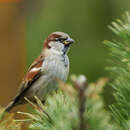en
names in breadcrumbs


House Sparrows use a set of postures and behaviors to communicate with others of their species. House Sparrows also have a set of vocalizations that are used to attract mates, deter intruders, and warn others.
Perception Channels: visual ; tactile ; acoustic ; chemical
When first introduced into the United States in 1851, house sparrows were protected from predators and fed. However, populations expanded enormously in North America and they were soon considered a nuisance species. Since the 1960's, with the changes in farming to larger, single crop farms, populations have declined. They are not, however, seen as threatened and are not included in most Canadian and U.S. regulations.
US Migratory Bird Act: no special status
US Federal List: no special status
CITES: no special status
State of Michigan List: no special status
IUCN Red List of Threatened Species: least concern
Because of their preference for human-modified habitats, house sparrows are considered a nuisance species, an aggressive competitor with native birds, and an agricultural pest. Large aggregations around buildings produce annoying noise and large quantities of feces.
Negative Impacts: crop pest; household pest
House sparrows are well-suited for studies of general biological problems, such as the way animals evolve and pest control.
Positive Impacts: research and education
House sparrows are abundant near human habitations. In these areas they serve as an important prey base for birds of prey and they may have an impact on plant communities because they consume large quantities of seeds. House sparrows seriously impact populations of native birds, such as bluebirds, chickadees, cliff swallows, and some woodpeckers. House sparrows take over the nesting cavities of native birds, including expelling adults and nestlings by force.
House Sparrows eat various kinds of seed supplemented by some insects. Rural birds tend to eat more waste seed from animal dung and seed from fields, while urban birds tend to eat more commercial birdseed and weed seed. Studies of the contents of House Sparrow stomachs in Alabama, Conn., Illinois, Iowa, Mass., Michigan, Miss., Penn., and Vermont have shown approximate amounts of seed to be 60% livestock feed (corn, wheat, oats, etc.), 18% cereals (grains from storage or from fields), 17 % weed seed, and 4% insects.
Animal Foods: insects; terrestrial non-insect arthropods
Plant Foods: seeds, grains, and nuts; fruit
Primary Diet: omnivore
The House Sparrow is distributed worldwide (excluding the Poles). It is native to Eurasia and North Africa. It was introduced into S. Africa, South America, Australia, New Zealand, and America. Its introduction into North America occured in 1851, when a group of 100 birds from England was released in Brooklyn, New York.
Biogeographic Regions: nearctic (Introduced ); palearctic (Native ); ethiopian (Native ); neotropical (Introduced ); australian (Introduced )
House Sparrows like areas that have been modified by humans, including farms, residential, and urban areas. They are absent from uninhabited woodlands, deserts, forests, and grasslands.
Habitat Regions: temperate ; terrestrial
A wild House Sparrow lived to be 13 years and 4 months old, though most will live for only several years.
Range lifespan
Status: wild: 13.0 (high) years.
Average lifespan
Status: wild: 189 months.
The House Sparrow is a stout, stocky sparrow, with shorter legs and a thicker bill than indigenous American sparrows. Members of both sexes are brown backed with black streaks throughout this area. Its underside is pale buff. Males have white cheeks and a black bib, while females do not. The tail is usually three-quarters the length of the wing. Wing length is 76 mm and average mass is 28.5 grams.
Average mass: 28.5 g.
Other Physical Features: endothermic ; homoiothermic; bilateral symmetry
Sexual Dimorphism: male more colorful
Average mass: 25.3 g.
Many hawks and owls hunt and feed on house sparrows. These include Cooper's hawks, merlins, snowy owls, eastern screech owls, and many others. Known predators of nesting young or eggs include cats, domestic dogs, raccoons, and many snakes. House sparrows avoid predation by foraging in small flocks so that there are many eyes watching out for potential predators.
Known Predators:
Mating System: monogamous
House Sparrows form monogamous pairs for each breeding season. Nests are built between February and May. House Sparrows nest in crevices inside and on buildings, and in coniferous and deciduous trees. Nests are built from dried vegetation, feathers, strings, and paper. Eggs are layed at any time in the nesting period. One to eight eggs can be present in a clutch, with the possiblity of four clutches per nesting season. Incubation begins after all the eggs have been layed. Both males and females incubate the eggs for short periods of a few minutes each. Incubation lasts for 10 to 14 days. After the eggs are hatched, both males and females feed the young through regurgitation.
Breeding season: February through August in North America
Range eggs per season: 1.0 to 8.0.
Average eggs per season: 5.0.
Range time to hatching: 11.0 (high) days.
Average fledging age: 14.0 days.
Key Reproductive Features: iteroparous ; seasonal breeding ; gonochoric/gonochoristic/dioecious (sexes separate); sexual ; fertilization (Internal ); oviparous
Average eggs per season: 5.
Both males and females incubate eggs and brood young until they have fledged. Both parents also provide their young with food.
Parental Investment: altricial ; male parental care ; female parental care